Winter Alpine Climbs in the Cascades
Winter is my favorite season to climb in the Cascades, in fact I feel that winter is when alpinism really happens here. What are trifling peaks in summer become true Nordwands in the winter; objectives that are already large in the summer take on a near Alaskan scale when attempted in the cold, dark winter months. The short days, terrible weather, huge snow pack, thin ice, and lack of plowed roads all tip the scales against the winter alpinist. These conditions, however, create a hot crucible through which hard alpinists are forged; success in the Cascades in winter is a good predictor of success in the greater ranges. At any rate, after a long winter of throwing one's self against Cascades' north faces, that spring trip to Alaska, the Andes, or Asia will seem like a tropical vacation.
How's Your Safety?
All of these routes should be considered potentially dangerous during periods of moderate and high avalanche forecasts.
Check the forecast before you go and insist on good conditions. Folks have died in avalanches on or nearby most of these peaks. Take an AIARE class and outfit yourself appropriately. Climbers have lost fingers and toes to frostbite on some of these mountains so, know how to dress yourself.
A Note on Clothing and Gear
The Cascades have nasty weather, especially in the winter. In the wet maritime environment synthetic insulated clothing shines and more than makes up for its weight and bulk penalty when the s#%t hits the fan. If your planned route requires more than one or two bivouacs, a synthetic sleeping bag is also golden.
Insulated single leather boots mountaineering will get you through most climbs during most weather with the exception of Mt. Rainier. I recommend a double plastic or the modern 6000 meter boots for Rainier or other committing routes that require more than one bivouac. Also, during periods of Artic high pressure systems, conditions can be extremely cold and single leather boots won't cut it even on the lower peaks.
The typically low elevation of the Cascades plus cold weather means bad news for butane canister stoves. Call me once burnt, twice shy, but I like white gas stoves in the winter. They are worth the extra weight and hassle to me, although some climbers have reported good success using the newer butane stove systems like the MSR Reactor. Some climbers use a hanging butane canister stove inside a tent, but be mindful this practice is NOT recommended or considered safe as carbon monoxide poisoning is a serious threat and one must vent the tent properly. Bring multiple pairs of gloves and mittens. A pair of Dachenstein boiled wool mittens will keep your digits pink long after Primaloft or fleece has soaked through. To improve circulation to your extremities, take one aspirin and one garlic tablet a day. Aspirin thins the blood and garlic makes the platelets less sticky. Beware you will bleed like a hemophiliac if cut.
This blog post has great information on clothing systems.
A Cascades winter alpine rack will typically consist of:
2 KB/Bugaboo pitons
#1, #2 angle pitons
6 medium to large nuts
.5, .75, 1, 2 cams
8 single slings, configured as alpine draws
1-2 Screamers
2 double slings with locking biners
6 ice screws, mostly short with one long one for v-threads
2 24" pickets
Abalakov V-Thread hooker
20 meters tat for building rappel anchors
This is a general list and should be tweaked for each individual route.
For Traveling Climbers
I would never suggest to another climber to travel to the Cascades to climb in winter. The weather is simply too fickle. If you can't resist the lure of a winter ascent of Mt. Rainier or a run up the classic Triple Couloirs and must travel here to climb in winter I would recommend one of two strategies:
1)Watch the weather and avalanche forecasts and keep your ear to the ground and drop everything and go for it when you find favorable conditions. Cascades locals may not have invented the "Smash and Grab", but they seem to have perfected it.
2)Time your trip for the most reliable weather window; Presidents' Day weekend in Februrary. The Cascades typically enjoy a high pressure system around the Presidents' Day weekend, sometimes for a few days and some times for a couple of weeks.
In either case have backup plans. East side routes can have better weather than Mt Rainier. Bring skis if that is your thing. Be flexible and you can probably make something of a bad weather vacation.
The Baker's Dozen
This list I am proposing is what I see as being essential winter routes for the aspiring Cascades based alpinists. Rather than compiling a list of the biggest and hardest winter routes completed to date, I selected routes that represent the range of commitment and difficulty experienced here in the winter. This selection is arbitrary and is based primarily on my own experiences climbing these and other winter routes and my own thoughts on what makes a 'good' winter route. Furthermore, this list is compiled with an eye towards accessibility. Most of these routes offer good to reasonable access at some time of the 'winter'.
One should note the quotes in winter. I include the shoulder seasons as being fair game for winter ascents as many of these routes are best done either before or after the winter solstice and spring equinox. The list is organized by difficulty and commitment with the easier ticks appearing first. Again, this is arbitrary, based on my own personal and subjective ratings.
North Twin Sister, West Ridge
With reasonable winter access the West Ridge of the North Twin Sister offers an interesting and moderate mixed outing. The grippy nature of the rock inspires confidence in the budding mixed climber. The season is long as the ridge can be climbed in many different conditions.
Excellent page on the Twin Sisters
Chair Peak, North Face, NE Buttress
![Chair Peak]() Chair Peak in Winter
Chair Peak in WinterChair Peak is the embodiment of winter accessible climbing in the Washington Cascades. The nearby ski resort at Snoqualmie Pass ensures access to alpine, waterfall, and bolted mixed climbing all season long. The mid altitude is also very good for reliable icing conditions, as temperatures can swing from warm days to very cold nights. In a cold, dry year the frozen waterfall climbing is not bad either. The Northeast Buttress and North Face routes are the most reliable while the East Face sees an ascent every so often. The season is reasonably long, I have climbed it in winter conditions early November through early April. Be aware of avalanche danger. People die in avalanches every few years here.
![On the ridge just below the...]() Climber on Chair Peak in Winter
Climber on Chair Peak in Winter![Excitable Boy on Chair Peak]() The author on P.1 of the NE Buttress in fat conditions
The author on P.1 of the NE Buttress in fat conditions![Martin Cash setting the...]() Climber on Chair Peak in Winter
Climber on Chair Peak in WinterMt Shuksan, North Face, NW Couloir, White Salmon Glacier
The proximity to the Mount Baker ski resort makes for a reasonable winter approach to the North Face, NW Couloir, or White Salmon Glacier routes on Mt. Shuksan. Insist on low avalanche risk days as the valley below the White Salmon is very avalanche prone. This aspect of Mt. Shuksan enjoys a long season with snow conditions and avalanche concerns being the long tent pole.
![Shuksan]() Climber starting up the North Face
Climber starting up the North Face![Shuksan]() Climber on the North Face
Climber on the North Face[
Excellent Mount Shuksan pageMt Stuart, North Face
The North Face of Mount Stuart offers several good mixed lines late in the season; typically March and April offer the best ice. The Stuart Glacier Couloir is hard to beat for its moderate grade while the NW couloir offers more and harder ice climbing.
![Stuart 5]() North side traverse above Stuart Glaicer Couloir
North side traverse above Stuart Glaicer Couloir[
Excellent Mt Stuart page
Dragontail, North Face
![Dragontail]() Climber below the North faces of Dragontail and Colchuck Peaks
Climber below the North faces of Dragontail and Colchuck PeaksThe big North face of Dragontail Peak offers a number of great winter mixed routes including the Northeast Couloir, often best climbed early season, the famous Triple Couloirs and the Direct North Face both of which are best late season, March-April.
![Excitable Boy]() Author climbing the Second Couloir
Author climbing the Second Couloir![EB and Chris Simmons]() Author and Chris Simmons at a belay below the crux runnels
Author and Chris Simmons at a belay below the crux runnelsColfax Peak, North Face
One of the Black Buttes of Mount Baker, the North Face of Colfax Peak offers a couple of steep alpine options; the Cosley-Houstan Route and the less often climbed Polish Route. Late fall, October through December, before the road becomes impassible is typically the best time to attempt these routes. Colfax is best approached via the
Mt Baker Coleman-Demming approach
Photos from Ade Miller's ascent of the Cosley-Houston route Mt Hood, North Face
![Mt Hood, North Face]() The author approaches the North Face of Mt. Hood in late November.
The author approaches the North Face of Mt. Hood in late November.The classic winter North Face routes on Mt Hood follow one of the two gullies that can be seen climber's left of the obvious buttress. These routes enjoy a long season and have been climbed late fall through early spring.
https://www.summitpost.org/mount-hood/150189>Mount Hood page
Eldorado Peak, NW Ice Couloir
![Eldorado Peak in Winter]() Northwest aspect of Eldorado Peak in Winter
Northwest aspect of Eldorado Peak in Winter Perhaps the most interesting route to the winter alpinist, the Northwest Ice Couloir climbs out of the wild Early Morning cirque and threads an intriguing route up the wild side of the mountain. The route has been done late fall through early spring, road closures dependent.
![NW Ice Couloir - Eldorado Peak]() Eric Sweet climbing NW Ice Couloir in thin conditions
Eric Sweet climbing NW Ice Couloir in thin conditions![NW Ice Couloir - Eldorado Peak]() Low angled section mid-route.
Low angled section mid-route.
[
Eldorado Peak page
Trip report
Mt Graybeard, North Face
The big, intimidating North Face of Graybeard is best done in spring as soon as Hwy 20 re-opens, or make a long ski or short snow machine ride from Ross Lake.
![North Face of Graybeard 2]() Looking up the North Face
Looking up the North Face![Spindrift City]() The author gettig a mug full of spindrift
The author gettig a mug full of spindrift![North Face of Graybeard]() The author above the North Face bowl
The author above the North Face bowl![Rock traverse on Graybeard]() Climber high on the route
Climber high on the routeMt Rainier, North Face
Mount Rainier in winter: It's a B.F.D. More so for the north side routes including Curtis Ridge, Willis Wall, Liberty Ridge, Liberty Wall, and Ptarmigan Ridge. Unlike the south side routes which boast a plowed road to Paradise, these require much longer approaches and any attempt takes on an expedition quality. One young, strong pair of RMI guides attempted a fast winter ascent of Ptarmigan Ridge and ended up losing fingers and toes.
![Approaching Storm on Liberty Ridge]() Typical Rainier winter time weather
Typical Rainier winter time weatherBig Four, North Face
![Big Four Alpenglow]() North Face Big Four Mountain
North Face Big Four MountainThe North Face of Big Four rises steeply for 4,000 feet above the Mountain Loop Highway. A reasonable, short really, approach and good ice in late season (March seems to be a good month) make this impressive face a big tick. Take on any one of the ribs or gullies, they have likely all been climbed. Bring your ice climbing chops though, few are easier than WI4.
Trip report on Cascadeclimbers.comMt Index, North Face, East Face
North Face of Middle Peak, North Face of North Peak, Eve Dearborn Memorial Route, and Murphy's Law all make for challenging and committing routes on the Mount Index massive. Finding ideal conditions might be the hardest part. The low elevation and western placement make for very short and rare periods where conditions are favorable for a winter ascent.
Mount Index page
Photos of the F.A. of Murphy's Law on the east face of the North PeakJohannesberg Peak, North Face
![Johanesberg Peak]() North Face of Johannesberg Peak
North Face of Johannesberg PeakThe Northeast Buttress offers the safest way up this big 5,000 foot face. Best done by early January before snow fall or downed trees washouts close the road.
Johannesberg Peak page



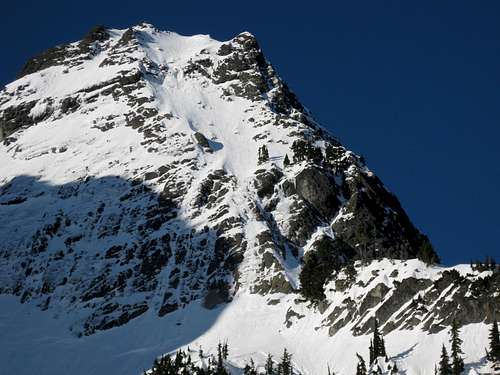



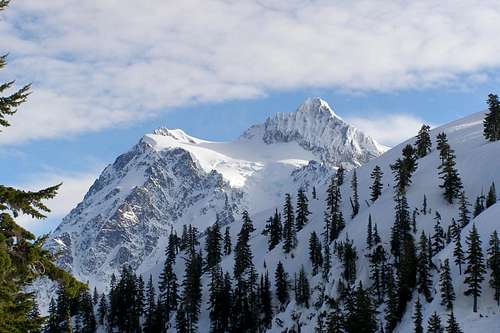

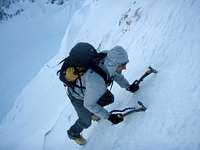

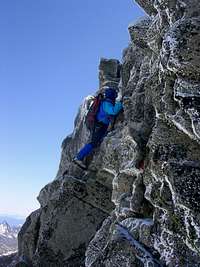
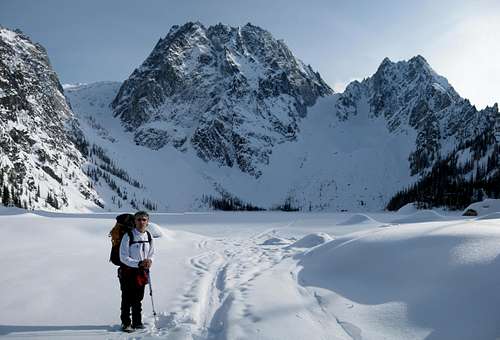

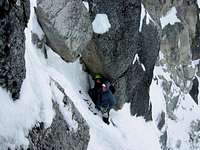



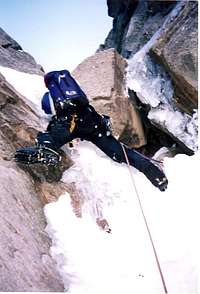
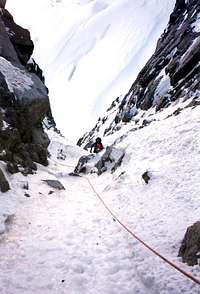
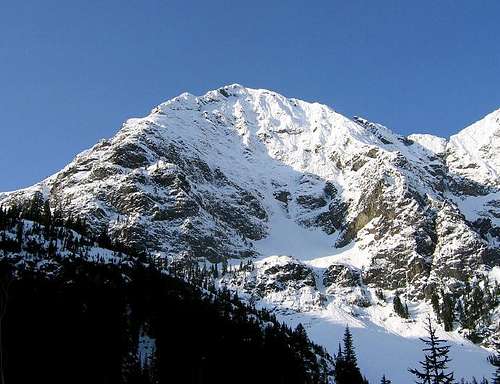



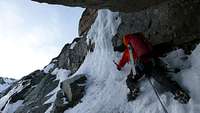


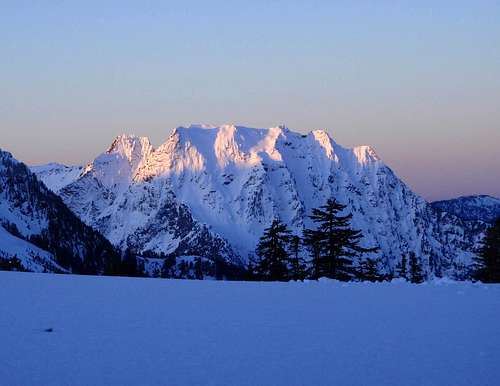
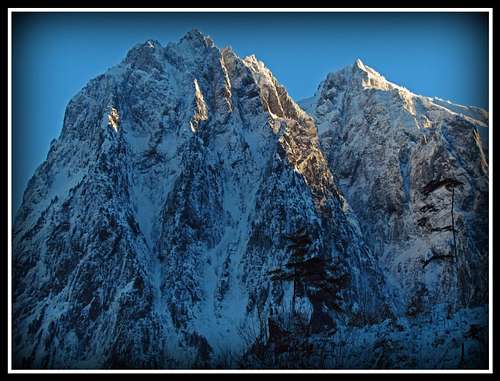
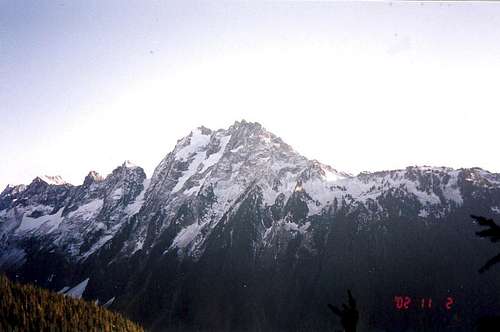







Comments
Post a Comment